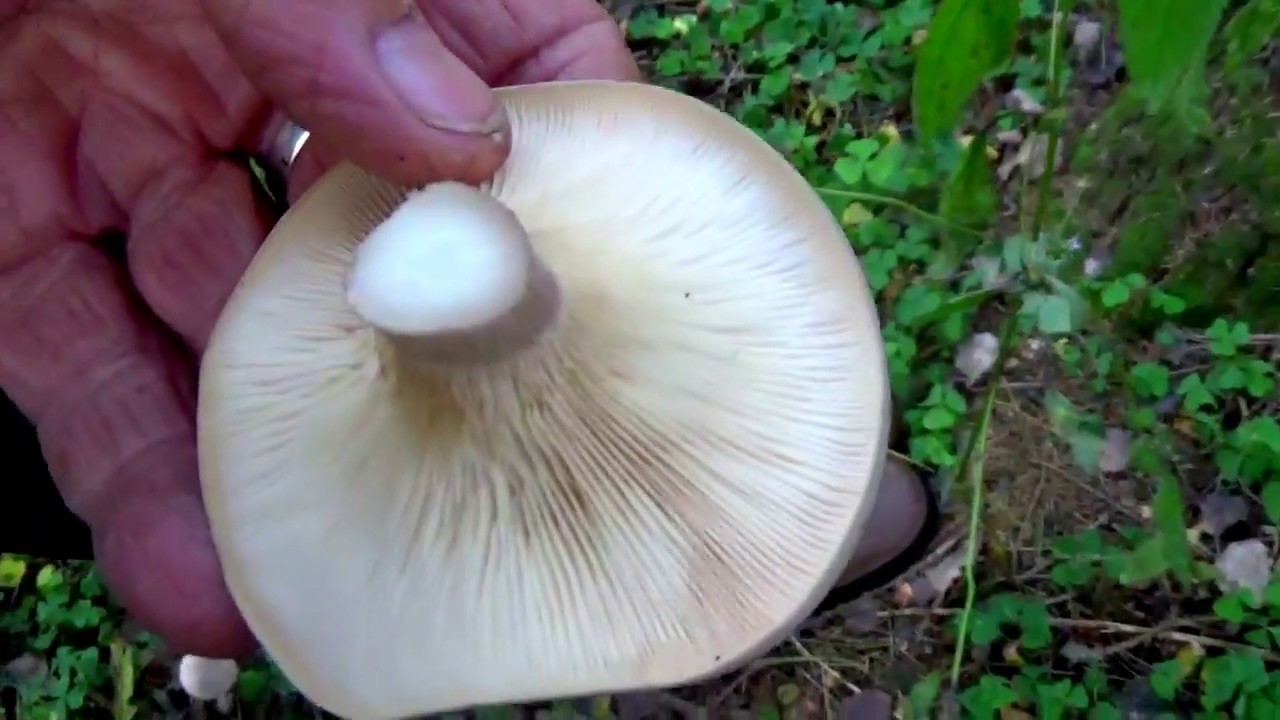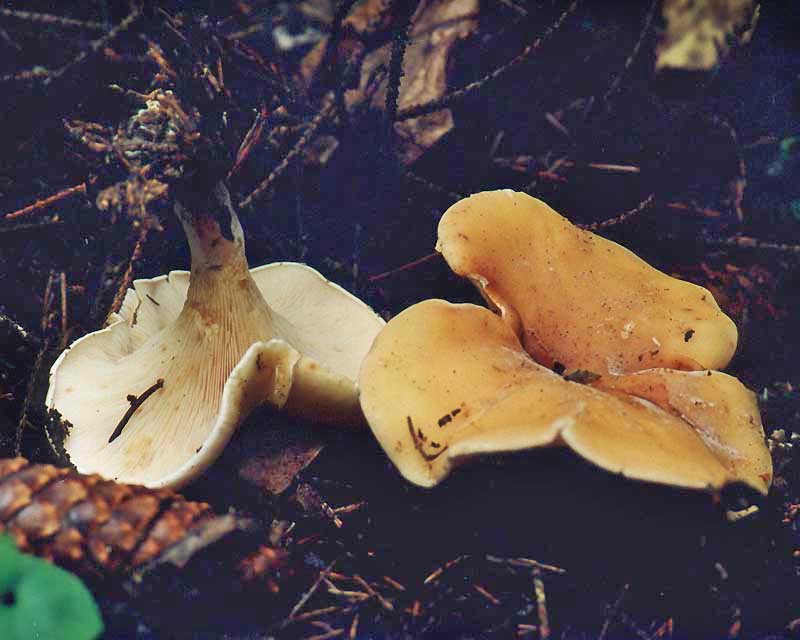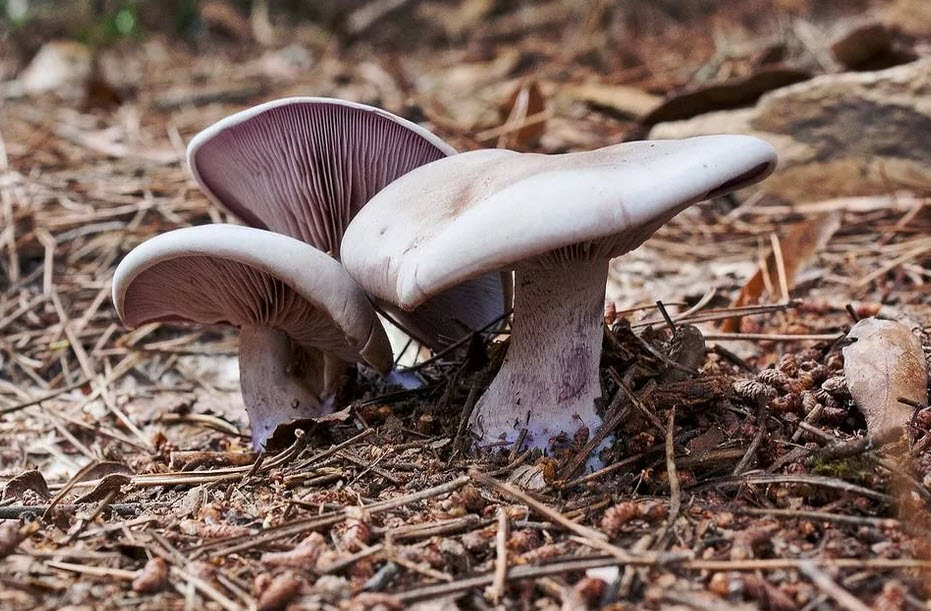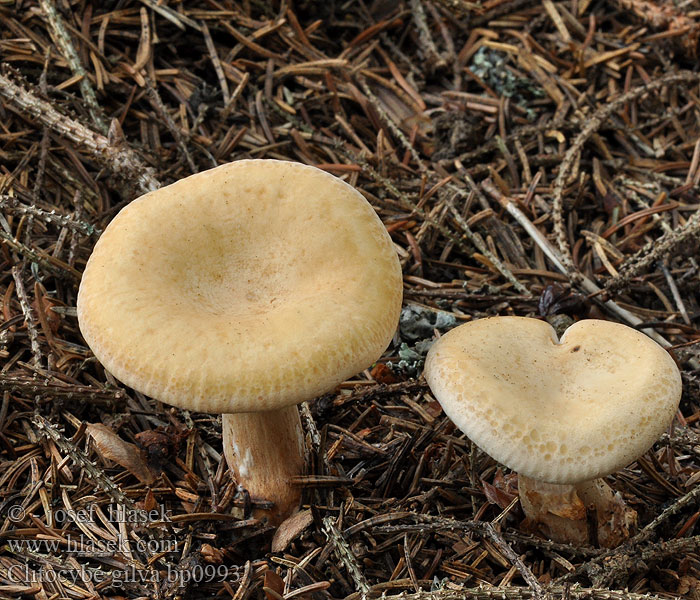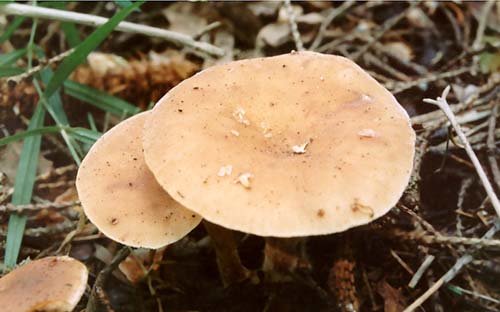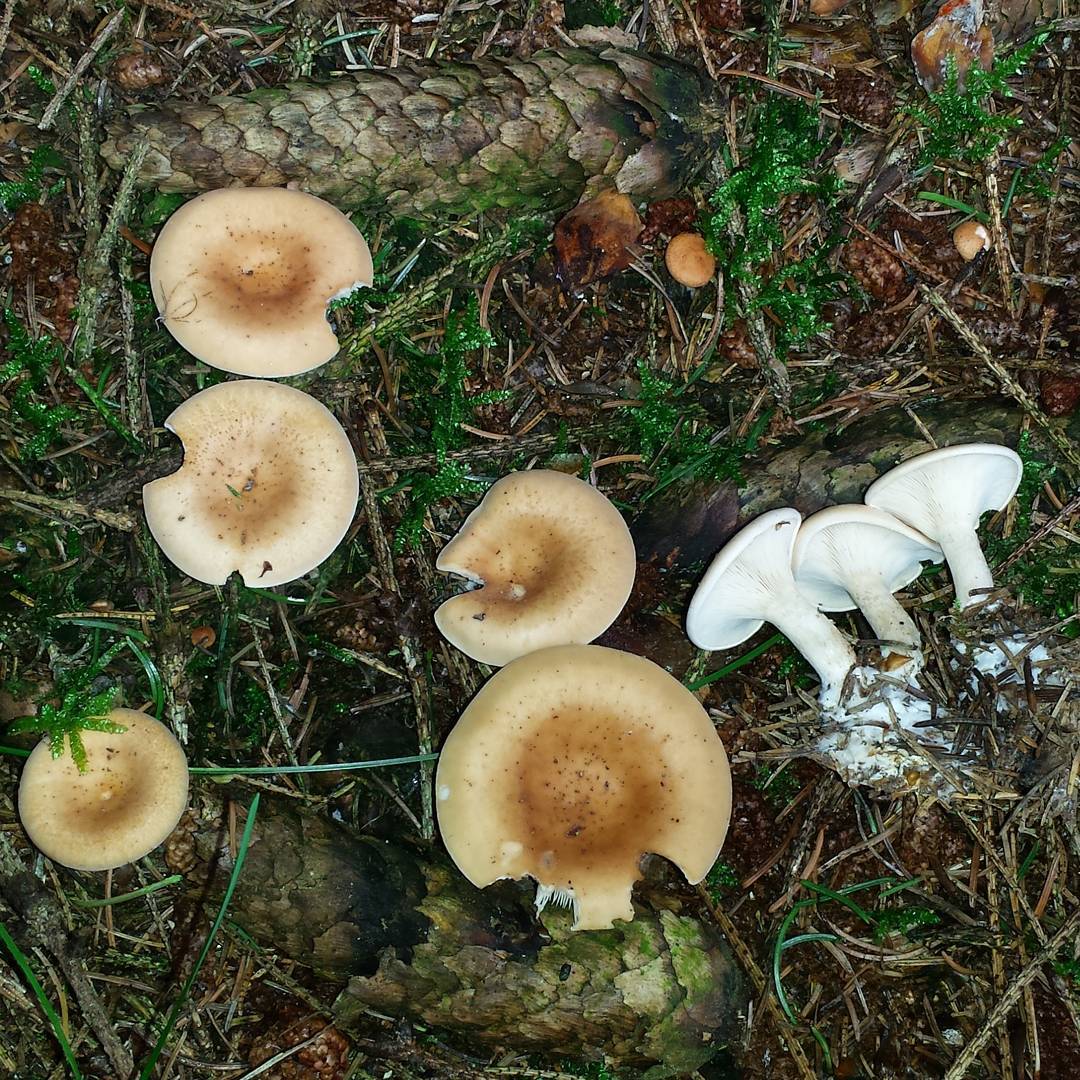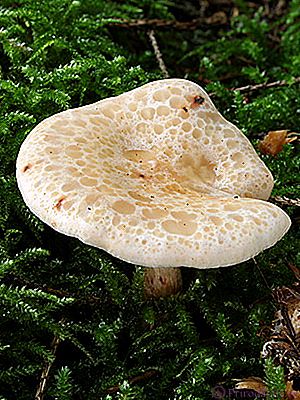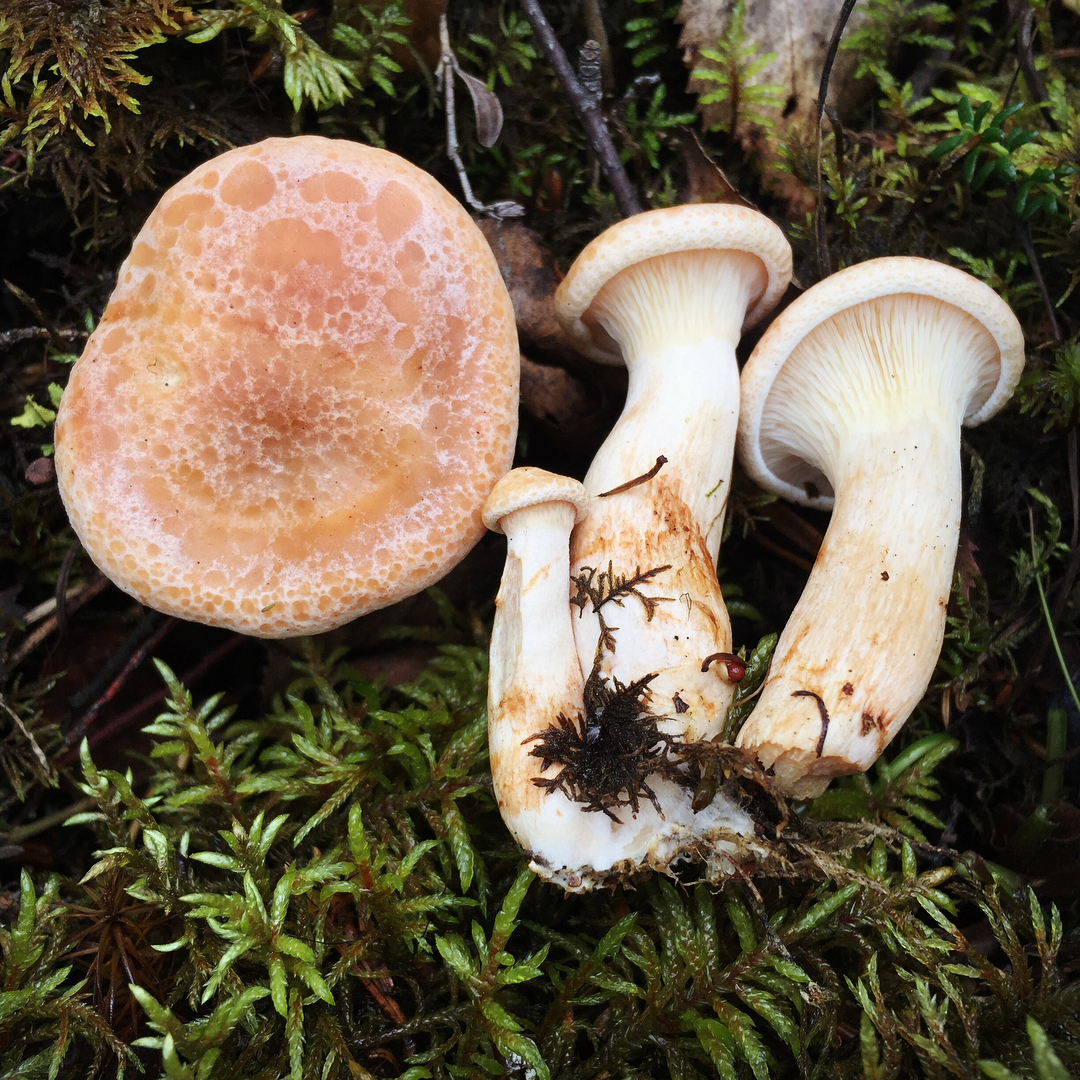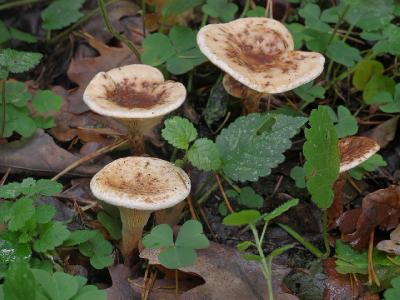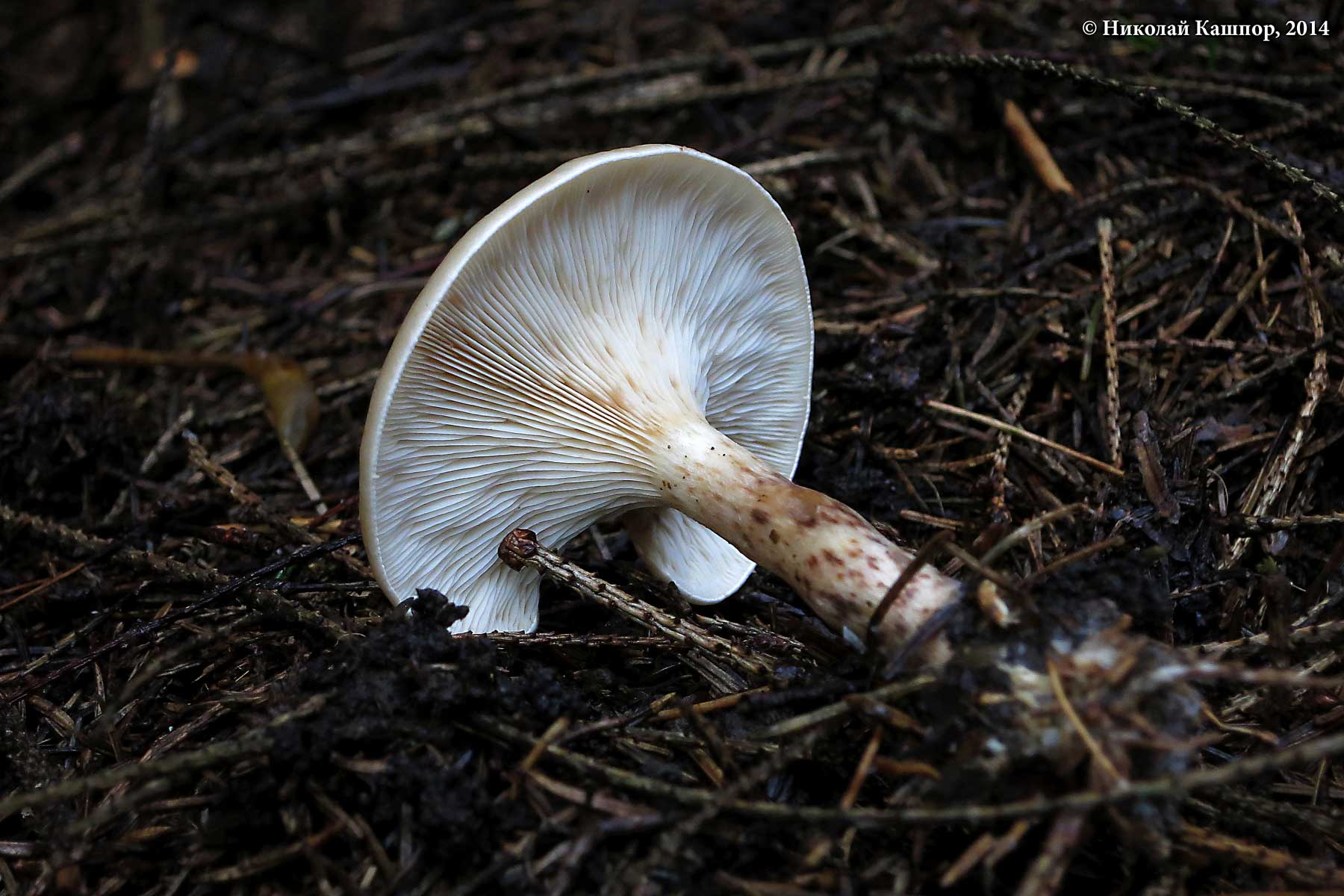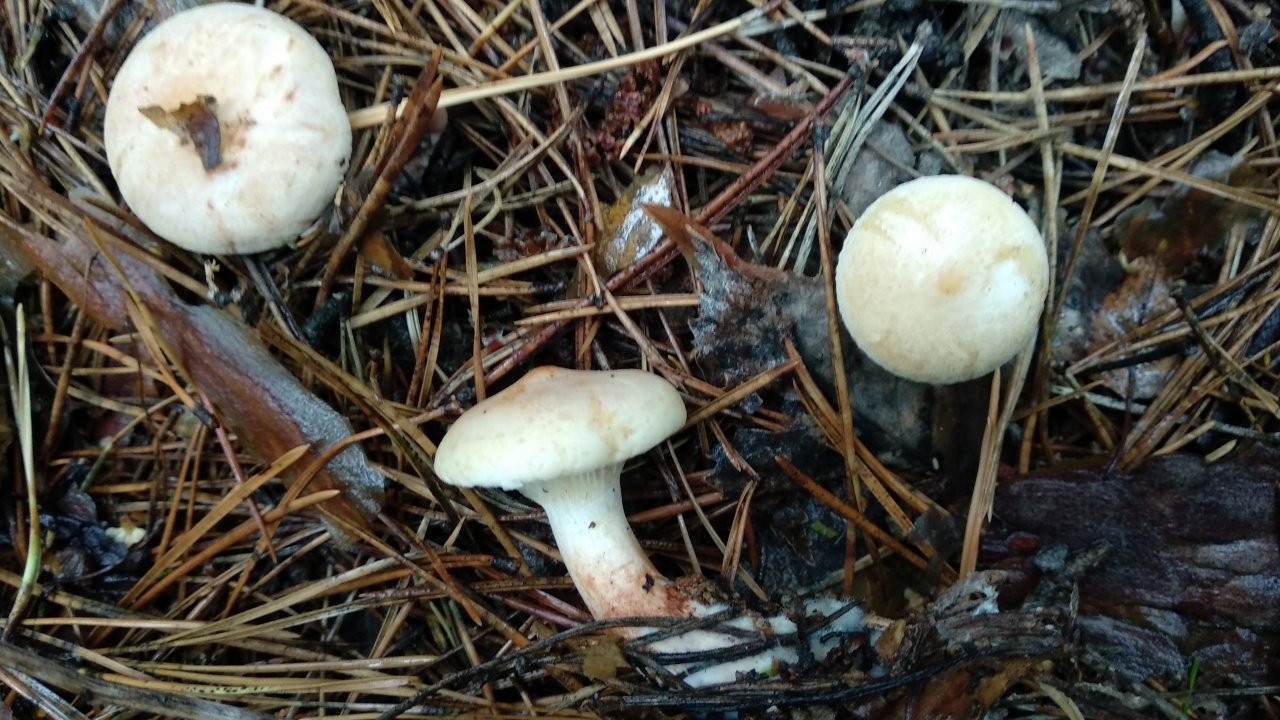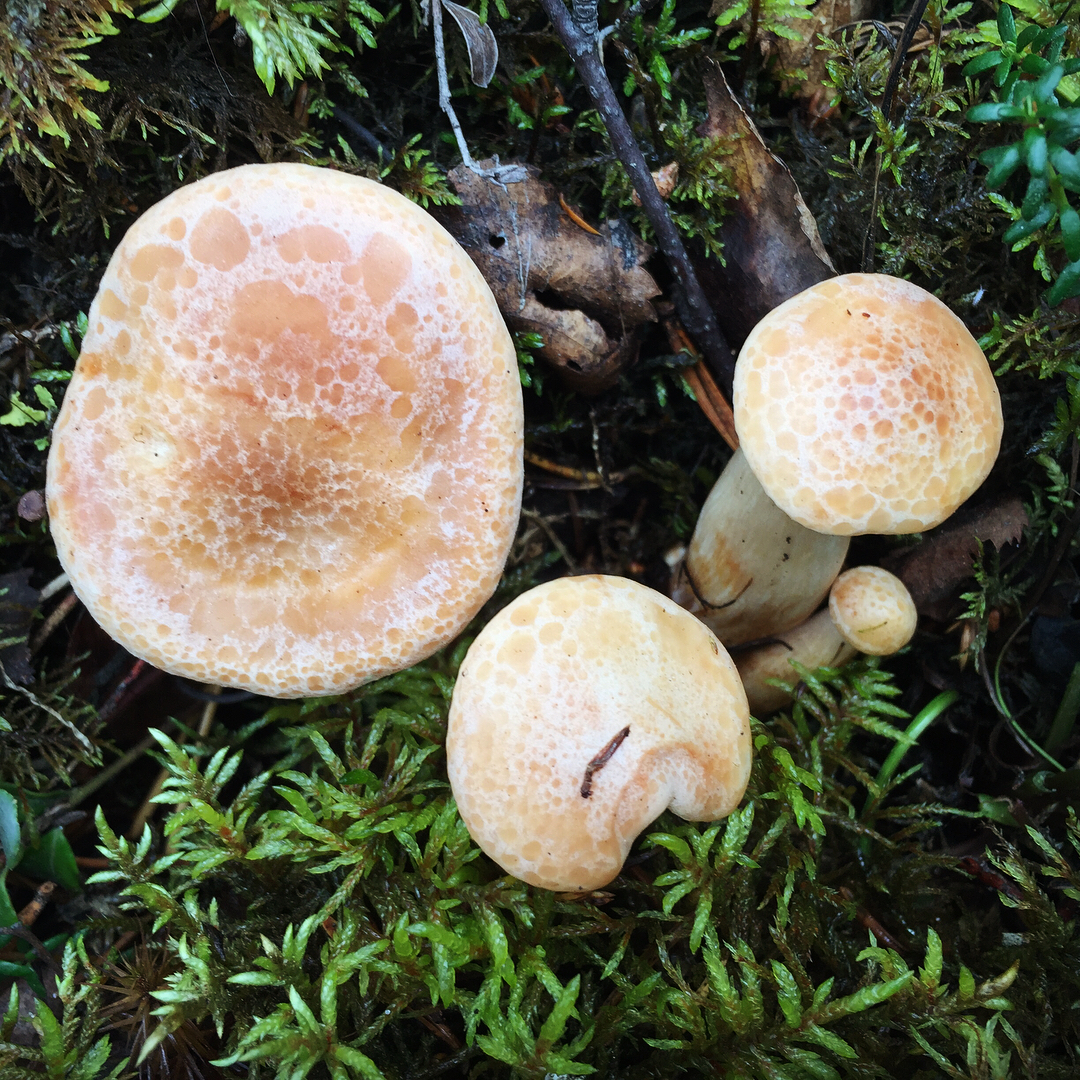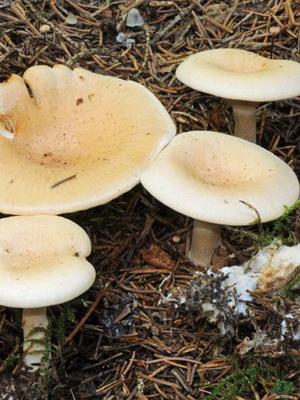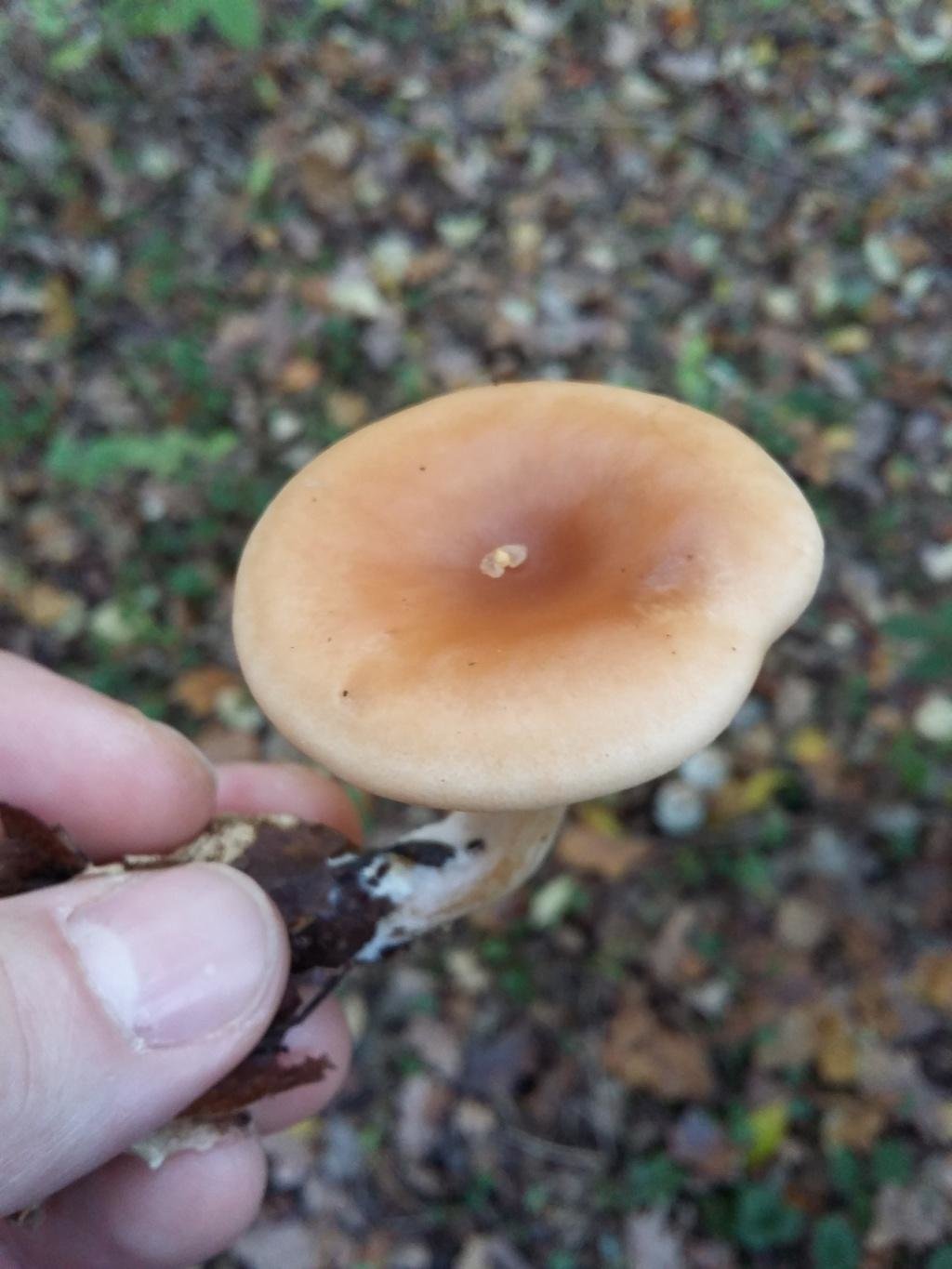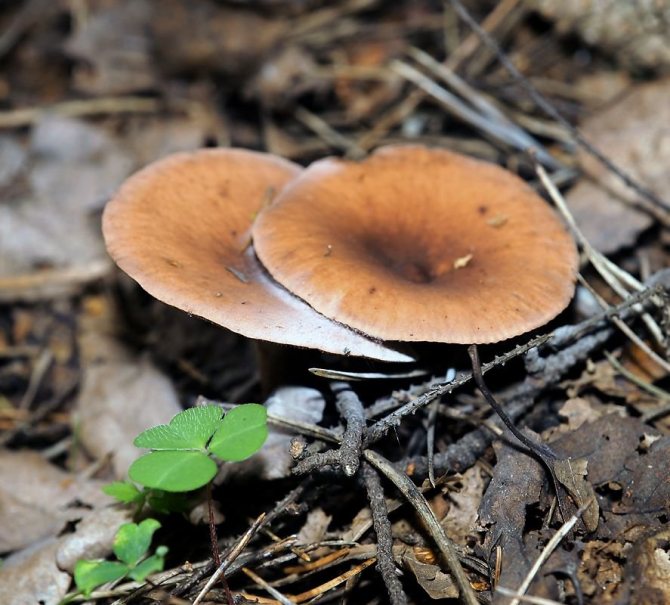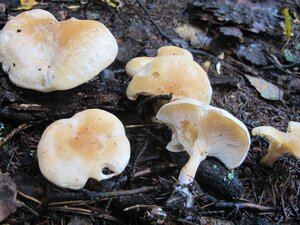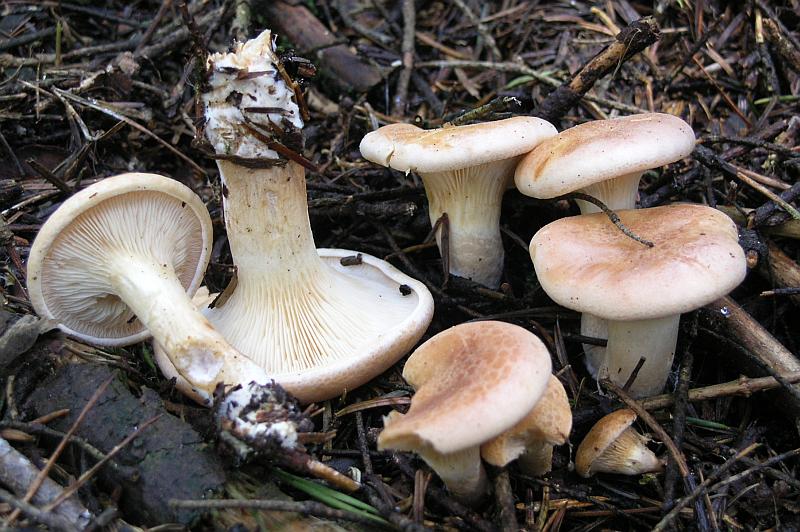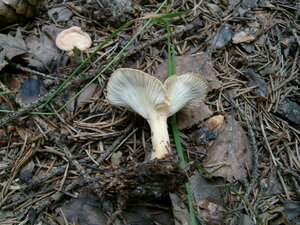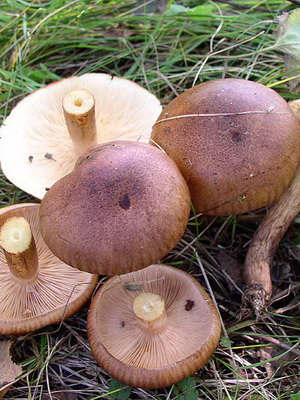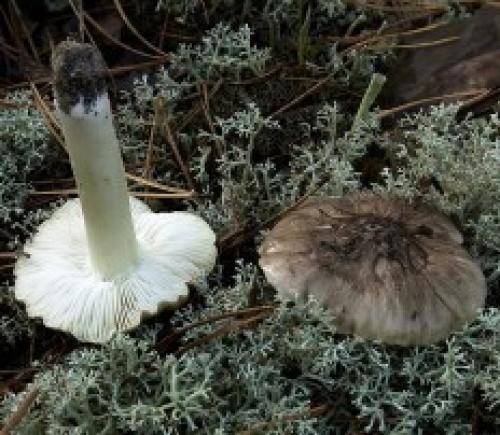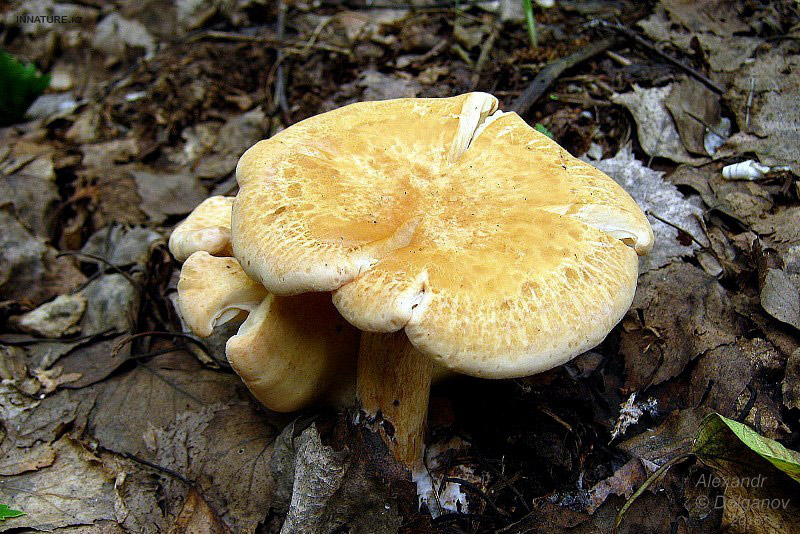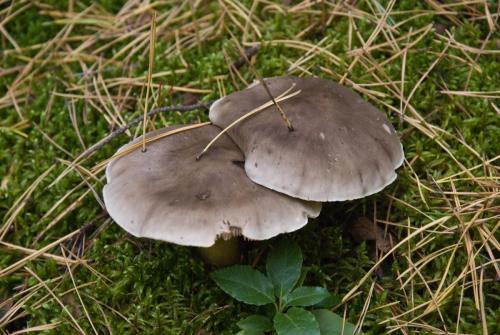Edible talkers with photos
In order not to confuse edible varieties with poisonous ones, they need to be able to distinguish them by their appearance. Distinctive features and description of edible varieties with photos are presented below.
Bent talker
This mushroom grows both singly and in large groups-circles, which are localized mainly at the edges of the forest, near roads and in thickets of bushes. The mushroom has a large smooth cap, the diameter of which often exceeds 12 cm. It is dirty yellow in color. The plates are white, gradually acquiring a pinkish tint.
The leg is dense in consistency and high, about 15-20 cm. The color is the same as the cap. The pulp is dry. In young mushrooms, it is white, and over time it becomes brown and acquires an unpleasant odor, therefore only young fruiting bodies need to be collected. The peak yield occurs at the end of summer and lasts until October. For cooking, only young mushrooms are used, which are pickled or boiled.
Gray
The hat of this variety is inferior in size to the previous one and has an average diameter of 8-15 cm. It is thick and fleshy in consistency, and can be in different shades of gray in color. The plates are also characterized by a gray tint. The leg is wide, dense, low, matching the color of the cap.
The pulp exudes a soap-like aroma. Most often, the mushroom is found in mixed and coniferous forests in large groups. It can be found in the forest from late summer to November. Before salting or pickling a gray talker, it must be thermally treated - boil for 30-40 minutes in boiling water.
Goblet
A special feature of this variety is a goblet-shaped hat with a diameter of about 7-8 cm. It has edges wrapped inward, a glossy surface and is painted brown or ash gray. There are few plates, they are brown in color. The pulp is thin, watery in consistency.
The leg is high, about 10 cm, part of the ground is fluffy and widened. You can meet the goblet variety in coniferous, mixed, deciduous forests, where the forest litter is rich in organic matter. The peak of fertility occurs in August and lasts until September inclusive. They eat the mushroom boiled or salted.
Orange
Orange talkers often grow in small groups or singly. Fruiting from late summer to October. They are found in the humid part of coniferous or mixed forests, the litter of which contains a large amount of moss and fallen rotten leaves.
The mushroom is small in size, yellow-orange in color, gradually becoming faded. The plates smoothly pass to the leg, when pressed, they change color to a darker one. The leg is low, on average 5 cm, rounded, becomes thinner closer to the ground. The pulp is yellowish, odorless. They eat only a hat that is fried or boiled.
Funnel
The name of the variety speaks for itself, since the shape of the cap is very much like a funnel, it is about 8 cm in diameter. The surface is dry, the edges are wavy, and has a dirty yellow color. The plates smoothly pass onto the leg. The pulp has a mealy odor. The leg is high, 8 cm long, thin, solid.
Funnel talkers belong to the most common varieties of this species, and they can be found on fallen leaves near forest paths, in thickets of bushes in small groups or singly. Heat treated before cooking. This species can be dried and also consumed together with other mushrooms.
Anisova
Anise talkers belong to the less common varieties of this type. The main feature of this variety is the changeable shape of the cap. So, initially the mushroom has a cap curved inward, which straightens over time. The color is predominantly green, with a gray tint. The leg is low, rounded.
Giant
You can meet a giant talker in open areas, where it grows from August to October.The hat has a funnel-shaped shape and edges bent outward. The diameter is 12-15 cm, but some representatives can grow up to 30 cm. The surface is pleasant to the touch, silky, milky in color. The leg is dense and high.
Read also Why does a woman dream of a dead horse
How to distinguish inverted talkers
The inverted representative of the Psatirella family is similar to related species: funnel-shaped, brown-yellow, water-spotted. Reddish-brown talkers are difficult to distinguish from related species. Nearby, in addition to external description, they use the sense of smell for identification. The scent of an inverted talker is reminiscent of a rotting orange, with a hint of bergamot.
- The funnel-shaped appearance is distinguished by a pale coloration on the cap, the absence of a wavy edge, as well as black dots on the surface of the cap. This variety has a characteristic mushroom smell.
- The brown-yellow appearance is distinguished by the general shade of the fruiting body. The cap and leg acquire a brownish-yellow tone over time. In young specimens, the color is even lighter: it is characterized as creamy yellow.
- The water-spotted type is distinguished by a white shade of the plates when broken, indistinct round spots on the surface of the cap.
Red-brown or upside-down talkers grow in whole colonies, and brown-yellow ones prefer to settle on stumps or near tree trunks in 1 - 2 pieces.
Golden row: photo, description and distribution
Golden ryadovka (Tricholoma auratum) is an edible mushroom of low quality, the peculiarity of which is the release of juice droplets. It is very easy to identify this fruit body; many experienced mushroom pickers claim that it is almost impossible to confuse it with other species.
The following description and photo of the golden row will help to understand the appearance and features of its growth.
Latin name: Tricholoma auratum.
Family: Ordinary.

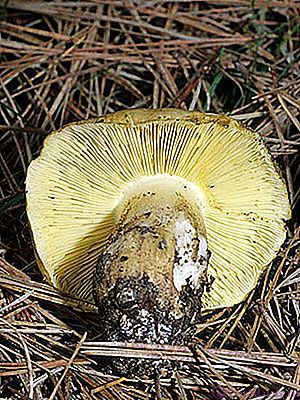
Hat: 6 to 10 cm in diameter, convex with curled edges. As they grow older, the cap becomes prostrate with a tubercle in the center. The surface has a characteristic orange-yellow color, and a darker brown-orange area is noticeable in the center. With the onset of rains, you can observe how the surface of the cap becomes slimy and slippery.
Stem: Has a pronounced area of reddish-orange scales. In addition, the stem of the golden ryadovka mushroom gives off droplets of juice, which is its characteristic feature.
Flesh: dense, white, has a weak flour aroma and a strong bitter taste.
Plates: rare, thin, white.
Edible: ranked among low quality edible mushrooms, however, due to the bitter pulp, it is considered an inedible and poisonous type of low toxicity.
Distribution: the entire territory of the temperate zone of the northern hemisphere.
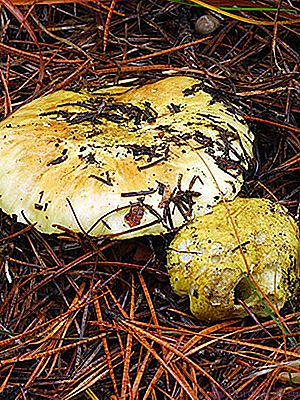
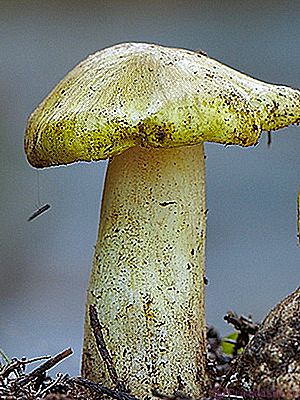
The photo shows that the golden ryadovka grows in groups in coniferous and mixed forests. Also, this type of fruiting body prefers lime-rich soils, sometimes growing alone. The mushroom picking season starts in July and lasts until October.
Inverted Talker (Paralepista flaccida)
- Red & brown talker
- Clitocybe flaccida
- Omphalia flaccida
- Lepista flaccida
- Clitocybe infundibuliformis sensu auct.
- Clitocybe inversa
- Omphalia inversa
- Lepista inversa
- Clitocybe gilva var. guttatomarmorata
- Clitocybe gilva var. tianschanica

Description
Hat with a diameter of 3-11 cm (sometimes up to 14 cm); at first it is convex with the edges tucked inward, with age it straightens out to a flat one or even takes the form of a shallow funnel or bowl; its surface is dry, almost smooth, matte, orange-brown or brick-colored; hygrophane (turns pale when dry). The edge of the cap is often wavy, with pronounced depressions such as the spout of a jug, which distinguishes this species from the similar funnel-shaped talker (Clitocybe gibba). There is evidence that sometimes in inverted talkers, which appear already very late in the fall, the cap remains convex, without forming the usual depression in the center.
The plates are descending, narrow, rather frequent, at first almost white, later pinkish-beige or pale orange, with age they become dark orange or pink-brown.
Leg 3-10 cm in height and up to 1.5 cm in diameter, more or less cylindrical, dry, finely pubescent; painted to match the cap, only slightly lighter; pubescent of whitish mycelium at the base.
The pulp is thin (in the cap), whitish, with a sweetish odor, which is sometimes compared to the smell of frozen orange juice or bergamot, without a pronounced taste.
Whitish to off-white spore print. Spores 4-5 x 3.5-4 µm, from almost spherical to broadly elliptical, finely warty, non-amyloid. Cystyds are absent. Buckled hyphae.
Chemical reactions KOH stains the surface of the cap yellow.
Ecology and distribution
Saprophyte, grows scattered or in close groups on a coniferous litter, often at the foot of anthills, sometimes on wet sawdust and wood chips. More often found in coniferous and mixed forests, sometimes it grows on humus-rich soils, where it forms spectacular "witch rings". A common species in the Northern Hemisphere, common in North America, mainland Europe and Great Britain. The period of active growth is autumn, until the onset of cold weather, however, in some places it can shift to winter (for example, the coast of California), or continue - in mild climates - until January (for example, in Great Britain and Ireland).
What can be confused with an inverted talker
The funnel-shaped talker (Clitocybe gibba) found in the same biotopes is distinguished by a paler coloration, the absence of a wavy edge, and significantly larger, elongated white spores. In addition, it has a much thicker flesh in the cap. Brown-yellow talker (Paralepista gilva) has a lighter, creamy yellow or brownish-yellow hue, and round watery spots (in youth) or dark rusty-brown spots (in more mature specimens) are visible on the cap. The much larger Lepista multiformis is found in open grassy areas (meadows, roadsides, parks and lawns), and has been recorded in Europe (rather rare).
Edibility
According to some sources, the inverted talker is not poisonous, but its nutritional quality leaves much to be desired, and there is little point in collecting it. According to others, it is poisonous (contains muscarinic toxins).
Video about the mushroom Govorushka inverted:
| Name: | Inverted talker |
| Latin name: | Paralepista flaccida |
| Type of: | Inedible, Poisonous |
| Synonyms: | Red-brown talker, Clitocybe flaccida, Omphalia flaccida, Lepista flaccida, Clitocybe infundibuliformis sensu auct, Clitocybe inversa, Omphalia inversa, Lepista inversa, Clitocybe gilva var guttatomarmorata, Clitocybe gilva var tianschanica |
| Systematics: |
|
Those who have been picking mushrooms and berries for a long time know how to distinguish edible specimens. The Upside Down Talker is an inedible species that can attract inexperienced mushroom pickers with its appearance.
Places of distribution of giant talkers.
Giant pigs grow in forest glades. They can be found in the European part of Russia, as well as in the Caucasus. Sometimes giant rows form "witch circles".
Evaluation of the edibility of giant talkers.
The giant talker is edible, but it can provoke stomach upsets. This is a mushroom with mediocre taste, 4th category, conditionally edible. Giant rows can be eaten boiled or salted
It is very important to carry out the correct heat treatment of these conditionally edible mushrooms.

It is recommended to use only young talkers, as the old ones taste a little bitter. However, overripe specimens are suitable for drying.
Among the talkers, there are poisonous species, so they should be collected exclusively by experienced mushroom pickers. You should be aware that pigs are not combined with alcohol, as this can lead to serious poisoning.

The use of giant talkers for healing purposes.
The pulp of giant pigs contains antibiotics that are active against tubercle bacillus. The antibiotics are called clitocybin A and B. Giant talkers have antibacterial properties. They can be used to treat epilepsy.

After studying talkers, a large number of useful properties were revealed. They contain both animal and plant proteins, a large amount of trace elements, for example, copper, zinc, manganese, as well as vitamins B1 and 2. In addition, a variety of drugs are made from talkers: nebularin, diatretin and clitocybin.
Like other mushrooms, giant pigs are low-calorie, they can be used as a diet food. These mushrooms help to restore and cleanse the body, get rid of heavy metals, toxins and toxins.

In folk medicine, ointments and decoctions are used, which are made from talkers. They help remove stones and treat respiratory tract infections.
Related species of the giant ryadovka.
The snow talker is a conditionally edible relative of the giant talker. Her cap is convex or depressed, with thin drooping edges. The surface of the cap is smooth, gray-brown or gray-brown. The leg is dense, smooth, often curved. The pulp is odorless, with a cucumber taste, it is dense in the cap, and tough in the leg.
Snow talkers gather in May. They grow in light coniferous forests. They settle on the forest floor. Fruiting in groups. These mushrooms are rare.

A weak-smelling talker is an inedible representative of the family. In young specimens, the caps are convex, then they quickly open and become funnel-shaped. The color of the cap is brown or beige. The shape of the stem can be cylindrical or flattened; it is slightly paler in color than the cap. The pulp with a flour taste and smell, grayish color.
Low-odor talkers bear fruit in rare groups. They usually grow in mixed forests and pine forests. The growth period falls on December-January.
Processing and preparation
You can cook these mushrooms in different ways - fry, stew, pickle or pickle.
The main thing is to carry out additional processing before this, so you eliminate the risk of intoxication.
Fruit bodies are cleaned of forest debris, washed in several waters, cut into pieces and placed in a saucepan with salted water. Cooking time is 15 minutes. This is enough to remove bitterness and accumulated harmful substances from the pulp.
Popular recipes
Corn salad
Ingredients:
- mushrooms - 500 g;
- onion - 1 pc;
- carrot - 1 pc;
- eggs - 3 pcs;
- canned. corn - 1 can;
- chicken fillet - 500 g;
- salt, pepper, mayonnaise - to taste.
Cooking technology:
- the onion peeled from the husk, finely chopped, fried until golden brown in vegetable oil;
- grated carrots are added to the frying, stew for another 10 minutes;
- pre-cut and boiled mushrooms are placed with vegetables, fried until all the liquid is gone;
- in the meantime, boil chicken in salted water, cool, cut into cubes;
- chop the boiled eggs;
- all components are transferred into a deep bowl, canned corn without marinade is added;
- mix, season with mayonnaise, salt, pepper to taste.
Before serving, the salad is decorated with dill or parsley.
Mushrooms in sour cream
Many dishes can be prepared from mushrooms
Ingredients:
- young mushrooms - 0.6 kg;
- cream - 150 ml;
- salt, pepper - to taste;
- sour cream - 3 tbsp. l .;
- onion - 1 pc .;
- vegetable oil - 2-3 tbsp. l.
The onion peeled from the husk is cut into half rings, fried in oil, pre-boiled mushrooms are added, stewed over low heat until golden brown, salted, pepper.
Pour with a mixture of sour cream and cream, stir, cover, reduce the heat to a minimum. In 20-25 minutes the dish will be ready for tasting. It goes well with any side dish.
Meatballs in pots
Ingredients:
- chicken fillet - 1 kg;
- onions - 2 pcs.;
- garlic - 2-3 cloves;
- salt, black pepper, any spices - to taste;
- carrots - 2 pcs.;
- mushrooms - 300 g;
- rice - 120 g;
- vegetable oil - 2-3 tbsp. l .;
- tomato paste, sour cream - 3 tbsp each l.
The meat is cut into cubes, ground in a blender with peeled garlic and one onion. To this mass add pre-boiled and chilled rice, salt, pepper, sprinkle with spices, mix.
Then cut the second onion, mix with carrots grated on a coarse grater. They are sent to a frying pan, fried until golden brown, put boiled mushrooms cut into pieces. Fry for another 10-12 minutes. Pour with sour cream, add tomato paste, stir, stew under a lid for 5-7 minutes.
Balls are formed from the rice and meat mixture, rolled in flour, fried in oil. At the bottom of each container, 2-3 tbsp are placed. l. fry, then meatballs and cover them with a second layer of vegetables and so on to the very top.
Sprinkle with vegetable broth, sprinkle with spices, herbs and send to cook in an oven preheated to 180-190 ° C for 30 minutes.
Useful properties of yellow-brown rows.
The composition of the rows is quite rich - they contain minerals (potassium, manganese, selenium, calcium, copper, iron, sodium, zinc), 18 types of amino acids, all groups of B vitamins, as well as vitamins A, C, D, K and PP. And due to the content of the "trehalose" substance in the rows, they have a sweetish taste.
Rows are natural antibiotics, they destroy many types of pathogenic bacteria. In addition, they have antiviral, anti-inflammatory, antioxidant and immunomodulatory properties. With regular use of ryadovok, the work of the heart is normalized, the heart rate is restored, the condition of the vessels improves, the amount of sugar in the blood decreases, and the pressure drops. These mushrooms help to improve performance, relieve stress, and activate the brain. Mushrooms of this type have a positive effect on the functioning of the stomach and intestines. The structure of the liver improves, toxins and toxins are removed from the body.
With the systematic use of yellow-brown rows, the possibility of the formation of cancerous tumors decreases, in addition, these fungi inhibit the growth of negative bacteria. They increase resistance to flu and tubercle bacillus.
In folk medicine, infusions are made from ryadovki, which are used in the form of lotions for various skin diseases. In cosmetology, a powder from dried fruit bodies is used, on the basis of which a skin lotion is made, it helps to eliminate acne, excessive grease and irritation.
Contraindications for the use of yellow-brown rows.
Raw rows can cause quite serious poisoning. Fruit bodies tend to accumulate various anthropogenic substances, for example, cadmium, mercury, pesticides. Also, old, overripe mushrooms are harmful to the body.
Overeating can cause abdominal pain. It is not recommended to use these mushrooms for chronic diseases of the stomach and intestines, gall bladder and with low acidity.
Similar species.
The poplar ryadovka is outwardly similar to the yellow-brown ryadovka, but it differs in its white hymenophore and in the fact that it grows under poplars and aspens. Her cap is slightly convex at first, and then straightens. The structure of the cap is fleshy. The color of the cap is brownish, there may be a reddish tint. The leg is cylindrical, solid, pink-brown. When pressed, brown spots appear on the leg. The pulp is soft, with a pleasant smell, brownish color.
These conditionally edible mushrooms bear fruit from August to October. Poplar rows grow in whole ridges. They can be found in deciduous forests and parks.
The white-brown ryadovka also has an external resemblance to the yellow-brown ryadovka. This is a conditionally edible mushroom with a convex-outstretched or flat cap. The surface of the cap is covered with small scales; in damp weather a layer of mucus is visible on it. The color of the hat is chestnut-brown or brown.The pulp is well developed, dense, white in color. It tastes not bitter, odorless. The leg is cylindrical, solid inside. The upper part of the leg is smooth, white in color, and below it is longitudinally fibrous, brown or brown.
White-brown rows bear fruit from August to October, but sometimes they come across in November. They grow mainly in coniferous forests, form mycorrhiza with pines, and can settle in deciduous forests. The range of white-brown rows is very wide.
Primary processing and preparation
Ryadovka yellow-brown is considered a conditionally edible representative of the mushroom kingdom and belongs to category IV. Those who have tried it say that it is not tasty and very bitter. This is probably why she is not popular with mushroom pickers. But if you know the secrets of its preparation, then the ryadovka will turn out to be a rather tasty addition to your table.
The yellow-brown ryadovka is harvested only at a young age, while the fruiting bodies are not yet very bitter. It is usually salted or pickled along with other types of mushrooms. It can also be boiled or fried, but after a preliminary 40 minute boiling and draining the water in which the rows were located.
The yellow-brown ryadovka is a seemingly completely unremarkable mushroom, but it will grow even when the year is dry and there are no mushrooms in the forest. This is probably why it is still sometimes collected. But in the mushroom year, most often this row is simply bypassed, giving preference to other representatives of the mushroom kingdom.
Waxy and giant talkers
Waxy talker is a rare poisonous lamellar mushroom. Grows singly or in small groups from late July to late September, preferring open, sunlit areas of mixed or coniferous forest with sandy soil or low dense grass.
In young mushrooms, the cap is convex, but in the process of growth it becomes slightly depressed or open, with wavy edges. There is a small tubercle in the center of the cap. The surface of the cap is smooth, matte, light gray in color, but in damp weather it darkens, and barely noticeable concentric zones appear on it. The spore-bearing layer is formed by descending cream-colored plates. The leg is rounded, even, wider at the base, solid inside. Its height is about 5 cm with a diameter of 1 cm. The surface of the leg of this poisonous talker is painted in an off-white color, its upper part is smooth, and the lower part has a slight pubescence. The pulp is thick, with an unpleasant odor, elastic in the leg, fragile in the cap.
The tissues of the waxy govorushka contain a poison that is dangerous to the human body, which can cause serious food poisoning.
Giant talker is a rare conditionally edible lamellar mushroom. It grows in large groups, forming the so-called witch circles, from late August to late October. Produces bountiful harvests annually. Prefers to settle in open areas of the forest, as well as in pastures.
The convex cap of the mushroom eventually becomes funnel-shaped, with thin, upward-curved edges. As a rule, the diameter of the cap of a mature mushroom does not exceed 13–15 cm, but there are also giants with caps up to 30 centimeters or more in diameter. It was they who gave the name to this type of mushroom. The surface of the cap is matte, silky to the touch; depending on the habitat, it can be covered with small scales. Most often it is snow-white, less often the color of coffee with milk. On the underside of the cap there are descending plates with bridges. Their color changes from beige to yellow as they grow. The leg is white, dense, up to 8-10 cm high and about 3-4 cm in diameter. The flesh is also white, fleshy, firm, with a faint powdery odor, in old mushrooms with a bitter taste.
The giant talker belongs to the fourth category of mushrooms. It is eaten only after preliminary boiling, after which you can prepare the first and second courses from it, as well as prepare it for future use - salt or pickle.The mushroom pulp contains a natural antibiotic - clitocybin A and B, which has a detrimental effect on the tubercle bacillus.


